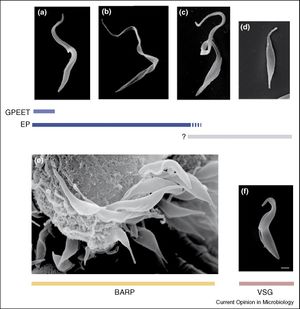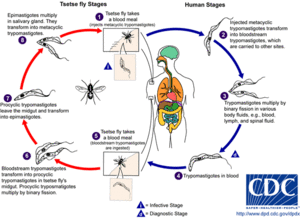Trypanosome Life Cycle

Introduction

Antigenic Variation
Development within Insect Vector
Development within Host
Conclusion
References
1. Krafsur, K. "Tsetse flies: Genetics, evolution, and role as vectors" Infection, Genetics and Evolution 2009. Volume 9 p.124-141
2. Taylor, J. Rudenko, G. "Switching trypanosome coats: what's in the wardrobe?" Trends in Genetics. 2006. Volume 22 No. 11
p.614-621
3. Donelson, J. "Antigenic variation and the African trypanosome genome" Acta Tropica. 2003. Volume 85 p.391-404
4. Nikolskala, O. Lima, A. Kim, Y. Lonsdale-Eccles, J. Fukuma, T. Scharfstein, J. Grab, D. "Blood-brain barrier traversal by
African trypanosomes requires calcium signaling induced by parasite cysteine protease" The Journal of Clinical Investigation.
2006. Volume 116 No. 10 p.2739-2747
5.
Edited by student of Joan Slonczewski for BIOL 238 Microbiology, 2009, Kenyon College.
